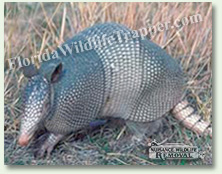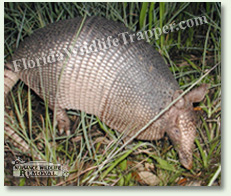
|
Armadillo The nine-banded armadillo is a cat-sized, armored, insect-eating mammal. Similar in form to an anteater, the bony, scaled shell of the armadillo protects it from attacks by predators. Armadillos often fall victim to automobiles and are frequently found dead on roadsides. Naturalists first observed nine-banded armadillos in the United States in 1849, in the Rio Grande Valley. Since then the peculiar mammal has expanded its range into the Southeast at a rate 10 times faster than typically seen in mammals. Although they are slow movers, average walking speed is about a third of a mile an hour, they can break into a run when startled. The nine-banded armadillo is a cat-sized, armored, insect-eating mammal. Similar in form to an anteater, the bony, scaled shell of the armadillo protects it from attacks by predators. Armadillos often fall victim to automobiles and are frequently found dead on roadsides. Naturalists first observed nine-banded armadillos in the United States in 1849, in the Rio Grande Valley. Since then the peculiar mammal has expanded its range into the Southeast at a rate 10 times faster than typically seen in mammals. Although they are slow movers, average walking speed is about a third of a mile an hour, they can break into a run when startled.
Armadillos are usually born in sets of four, all of the same sex. Each armadillo is a clone of its three siblings. One female can populate a new area. Armadillos live in burrows. A single armadillo may have up to 15 burrows (each 8 inches in diameter and 2 to 25 feet long) in its 10-acre range. Some burrows have several entrances for emergency access, but there is always a main entrance which the armadillo uses most of the time. Armadillos rummage through leaf litter for tasty grubs, worms and ants. The armadillo has a keen sense of smell and can sniff out insects six inches underground. When digging for them it will make 3 to 4-inch cone shaped holes which it will revisits to gobble up any new bugs or snails which may have slipped in. Its sticky, barbed tongue aids it in picking up its food. The armadillo has 30 to 32 teeth, all of them peg-shaped molars. The name armadillo, comes from Spanish and refers to its armor-like covering. The shell is made of a bone-like casing.
| ||||||||||||||||||||||||||
 Service Area Overview - Click here for more areas
Service Area Overview - Click here for more areas
Manatee, Sarasota, Charlotte,Orange, Hillsborough, Citrus, Hernando, Pasco, Pinellas, Polk, Lee, Palm Beach, Orlando, St. Lucie, Martin, Bradenton, Clearwater, Lakeland, Largo, Port Charlotte, St. Petersburg, Sarasota, Tampa, Tarpon Springs, Venice, West Palm Beach | |||
 Copyright 2011-2017 © Nuisance Wildlife Relocation, Inc. All Rights Reserved. FloridaWildlifeTrapper.com |
|||

 This "armor" consists of a large shield over the shoulders, a second large shield over the rump, and nine bands in the middle. Because the shell itself cannot grow nor be replaced as the armadillo grows, it is soft and leathery when the armadillo is born. It does not harden until the armadillo reaches its full adult size of 8 to 15 pounds. The armadillo has a particularly interesting method for crossing water. When faced with a stream, the armadillo will simply walk across the bottom, under water. However, when up against a wider body of water, the armadillo will swallow enough air to inflate its stomach to twice its normal size. This increased buoyancy then allows the armadillo to swim across. Afterwards, it takes the armadillo several hours to release all the excess air from its body.
This "armor" consists of a large shield over the shoulders, a second large shield over the rump, and nine bands in the middle. Because the shell itself cannot grow nor be replaced as the armadillo grows, it is soft and leathery when the armadillo is born. It does not harden until the armadillo reaches its full adult size of 8 to 15 pounds. The armadillo has a particularly interesting method for crossing water. When faced with a stream, the armadillo will simply walk across the bottom, under water. However, when up against a wider body of water, the armadillo will swallow enough air to inflate its stomach to twice its normal size. This increased buoyancy then allows the armadillo to swim across. Afterwards, it takes the armadillo several hours to release all the excess air from its body.